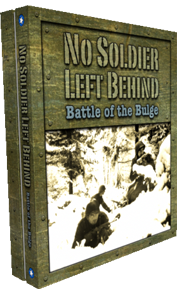The Focus System

No Soldier Left Behind introduces some new mechanics to both cooperative games and wargames. These mechanics are collectively called the Focus System.
Design Considerations
The Focus System has the following design goals:
- Naturally support and encourage emergent storytelling, particularly for telling the war stories that seldom get told in traditional wargames.
- Play quickly, with simple rules that present deep choices and offer a satisfying challenge.
- Emotionally tie the player to the soldiers in the historical context, and educate about real events.
- Present a game that is accessible to non-wargamers while still being satisfying to traditional "grognards".
The Focus Queue
The core of the game revolves around the concept of a Focus Queue.
Each soldier has a Focus Queue of three cards that represent where that soldier is putting his focus at any given moment. The cards have "focus" symbols on them, representing where the soldier is applying his focus at any given time.
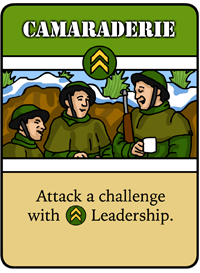
For instance, the Camaraderie card adds one point of Leadership focus to your soldier (denoted by the icon in the white bar), allowing him to perform better on tasks that involve interacting with his fellow soldiers or civilians you meet in the scenarios.
In addition to providing focus, each card lists an action that you can take if that card is in your Focus Queue. For instance, the Camaraderie card allows you to attack challenges which are susceptible to being resolved with Leadership efforts.
During the action phase, the soldiers can perform any and all of the actions they have showing in their Focus Queue, in any order. You simply flip over a card when you have used its action, allowing you to easily track which actions have been performed and which ones are still available.
Each turn, you remove the oldest card from the queue, and select a new card to add to the queue. Thus, each card you select has an effect on not just that one turn, but three. Planning ahead and cleverly choosing your cards is the key to victory.
You can choose any card from your deck; there is no "luck of the draw" that determines your options. Nothing stops you from implementing your chosen strategy!
Veteran Cards
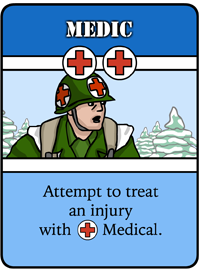
Unlike many wargames, where the individual soldiers are completely interchangeable, No Soldier Left Behind had as a design goal to differentiate each soldier in both capability and actions, while still keeping the gameplay clean and tight.
We use Veteran cards for this. These special blue cards act the same way that the regular Focus cards do, but they have special actions that aren't available to every soldier.
Each player draws a Veteran card for their soldier at the start of a scenario, and if you are playing the campaign version of the game, you can earn more Veteran cards for your soldier over the course of multiple scenarios.
My personal favorite Veteran card is the Memento card, which gives the soldier the ability to "rally" himself with an extra surge of courage by looking at a photo of the girl back home. Other cards include things like medical training, excellence in marksmanship, a natural aptitude for the forested region, and others.
Modular Board
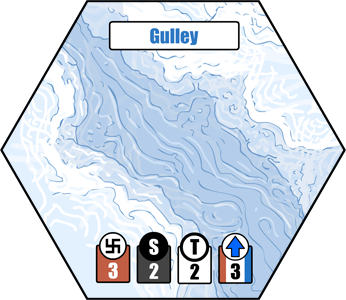
No Soldier Left Behind does not use a traditional game board. Instead, you build the game board using modular hex tiles like the one shown here.
Each hex is an abstract description of the terrain that is important to the scenario. They represent distances from 100 to 500 yards, and let the action focus in on the places on the battlefield where engagements are likely to occur or which represent strategically valuable positions.
Listed on the card, each hex has different values for tactical positioning, stealth, movement difficulty, and danger.
The Stealth and Tactics values are used to help soldiers avoid taking fire or otherwise being susceptible to negative effects from the enemy. Each soldier can take Stealth and Tactics tokens to avoid an attack, but not more than the value for the hex. In the dense forest, there are plenty of opportunities for stealth, but you can't hide in an open field!
The Movement Difficulty represents the amount of Movement focus you will need to accrue to move into that hex. Roads can be moved along quickly, but dense forests take more effort, especially if you are helping a wounded fellow soldier!
The Danger value represents how dangerous it is to enter the hex without reconnoitering it first. Some places are perfect for ambushes! When a hex is revealed, you place Threat tokens on it, and performing the Recon action on them can remove them. Moving into a hex without removing the Threat tokens first incurs a penalty that makes the game deadlier.
Challenges
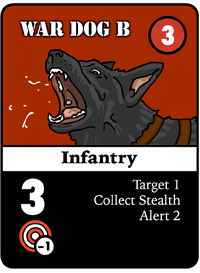
The scenario you are playing will bring out Challenge cards, which get played into the game to represent the forces that are endangering the heroes, from enemy forces to weather conditions.
Challenges have a strength value and a list of focus types they are susceptible to.
When you attack a challenge, you roll the "soldier" die, which will yield a number of stars. For each star, you can put a token on the challenge card, and when you have placed enough to match the strength value, the challenge is defeated.
Each turn, every challenge gets to perform its actions. They target one or more soldiers and perform the attacks listed.
Each type of unit has their own special effects. Many will fire on your soldiers, but some challenges do different, interesting things. The war dog alerts the enemy to your presence, making stealth difficult. And the intimidating King Tiger Tank, in addition to firing on you, forces you to discard cards with Bravery focus.
Injuries
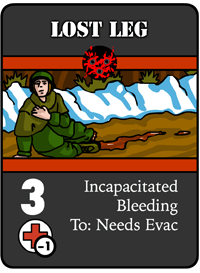
Eventually, your luck will run out. The enemy can overrun even the most carefully fortified positions, or your attempts at going unnoticed will be foiled.
When this happens, you will often be forced to roll the Wound die. If it comes up with an injury result, you must draw an Injury Card.
Injuries range from minor ankle sprains to losing limbs, and are not restricted to only physical injuries. Being demoralized can be just as deadly on the battlefield as taking a gunshot wound.
When you draw an Injury card, you add it to your Focus Queue, and discard all your Focus cards. It then stays in your queue permanently; when it would be removed, it is instead just added right back to the front of your queue, cluttering it up and preventing you from being effective as a soldier.
Luckily, your soldiers can perform first aid. Many injuries - the ones treatable in the field - are challenges, just like the enemies that come out. If you can bind that wound or wrap that ankle, your soldier's situation can be improved.

